I have had some strange fieldwork experiences, but none was stranger than Dabhol! It was an experience I will never forget.
Dabhol is an ancient town that was once a pulsating, Muslim trading centre—an important port, located on the western, Konkan coast of India (in Ratnagiri). Dabhol historically contributed to fostering centuries of stimulating Indian Ocean maritime relations in the 14th, 15th, and 16th centuries, and played a vital role in linking the Konkan to a larger, precolonial network of transoceanic trade. The town was partially conquered in the early 16th century by the Portuguese, who called it ‘Dabul’, and through its conquest, attempted to control maritime trade in the Arabian Sea. The spate of Portuguese attacks finally coalesced into a large battle that destroyed Dabhol’s vibrant, independent association with the Indian Ocean. As new ports emerged, Dabhol’s importance declined, even as it continued to function on a diminished scale under the Adilshahi rulers, who referred to it variously as Mustafabad and Hamzabad. Dabhol was conquered by Shivaji in the mid-17th century, and gradually thereafter, the port disappeared from the map of important maritime spaces in the Konkan.
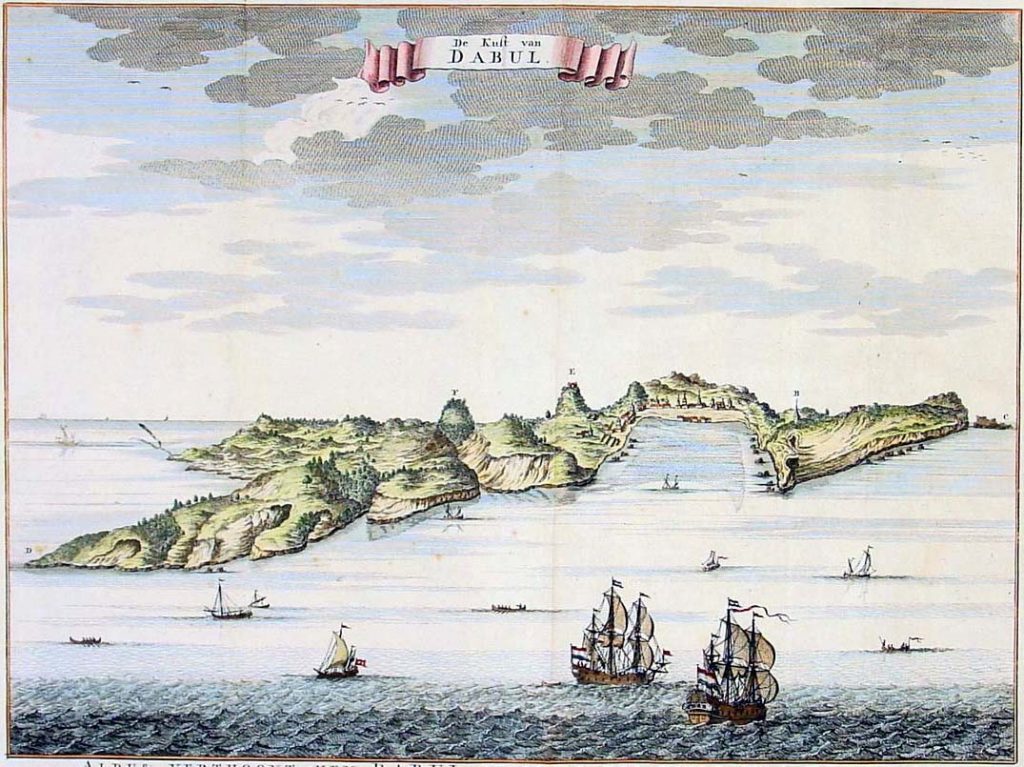
The Muslim residents of Dabhol called it a town of a hundred mosques. And it is true that Dabhol is home to many old, ruined structures, that populate almost every street corner of the old port region of town. And these ruins are identified as remnants of the town’s once famed status, as that of a hundred resplendent mosques, constituting a source of pride for local Konkani Muslims. Dabhol is indeed spectacular as a heritage space for Indian Ocean history. I was pleasantly surprised to find an almost intact shrine of Khwaja Khizr situated near the old dockyard, that to my knowledge, is one of the few shrines of Khizr in India. Though the shrine looks mostly dilapidated, it is not completely ruined. Mainly overgrown with trees that makes access to it impossible, the shrine of Khizr, is an imposing structure that is immediately visible from the sea, when approaching Dabhol by ship. And this neglect and dilapidation is recent, since an older generation of local Muslims in Dabhol still remember a time, when regular festivals were organized there, in commemoration of Khwaja Khizr.
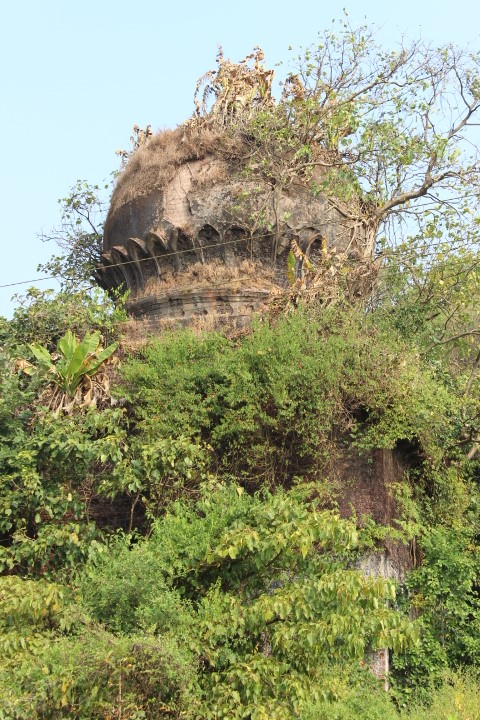
Though Muslims in Dabhol are mostly influenced by Wahhabi reformism, they are tremendously proud of Dabhol’s Konkani Muslim heritage, in which Khizr plays an important role. Khizr’s presence in Dabhol serves to memorialize Konkan’s Muslim identity and its historic association with the Indian Ocean Islamic world before the Portuguese. Khizr is a mysterious Muslim saint moreover, who like the goddess Hinglaj, connects the Konkan coastline with the Indus delta, the Sindh region of Pakistan, and from there, to the Persian Gulf, the Arabian Peninsula, and further, to the middle-east. A significant many Konkani Sufi shrines have a connection to Khizr, like Maqdoom Ali Mahimi in Mumbai, who identified with being Owaisi, and therefore, not connected to any tariqa. Being an Owaisi entailed being initiated by none other than Khizr himself, who was mysteriously encountered on the seacoast. Dressed in dazzling emerald colours, he is often reported glimpsed, riding a fish as if it were a ship in the Konkan, and he sometimes sports wings. Besides Khizr, Dabhol is also known for the famous “Anda” or egg mosque as it is locally known. Formally called the Shahi Masjid characterized by a perfectly round white dome looking rather like a pearl, the Shahi Masjid was built by Ayesha Bibi, the princess of Bijapur in 1660. Though it is said to be the oldest mosque in the Konkan, the claim is untrue, even for Dabhol itself, which has older structures from the Bahamani period. In fact, it was at the tail-end of the Adilshahis that the Shaji Masjid was built, completed around the same time, Shivaji captured Dabhol.
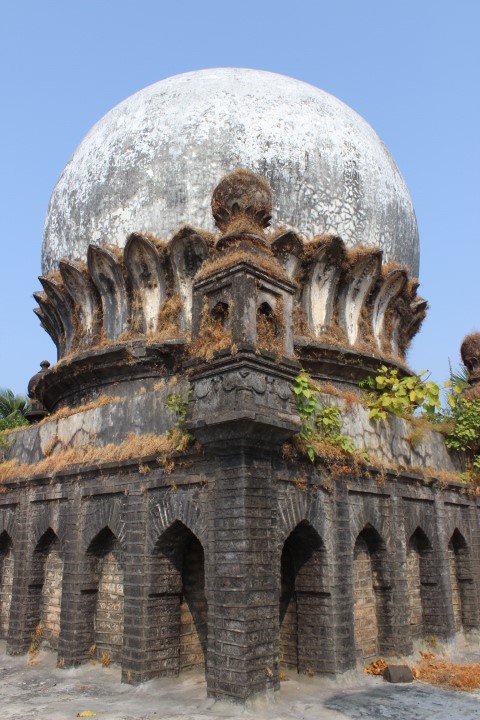
I made a rather hectic fieldtrip to Dabhol in 2014. I and a friend had initially decided to make a day-trip from Dapoli, where we were staying, and return to Dapoli in the night. We were all set to leave for Pune the next day, but the saints and spirits of Dabhol had a different plan for us. We misjudged the time we required to reach Dabhol and were beset by unexpected difficulties. First, we made the mistake of setting off on a full stomach in the morning. The road to Dabhol twisted and turned in the typical Konkani fashion, weaving through mountain passes, up and down small hills, and alongside steeply curvaceous sea-side roads, and before long, our stomachs were heaving with travel sickness. We had to slow down, and take frequent breaks. Then there were other unexpected delays, like an almost two-hour wait for a monitor lizard that lay basking in the sun to finish crossing her path. The lizard lay placidly on the tarmac, refusing to move, and there was no real traffic after all. It was impossible for us to skirt her, given the underbrush on either side of the road, and only after waiting interminably, did the lizard finally move, ambling unhurriedly into the nearby shrubbery. By the time we reached Dabhol, it was dark and there was no question of fieldwork. There were, moreover, no real hotels in Dabhol in 2014. We panicked as we began to look for a place where we could sleep.
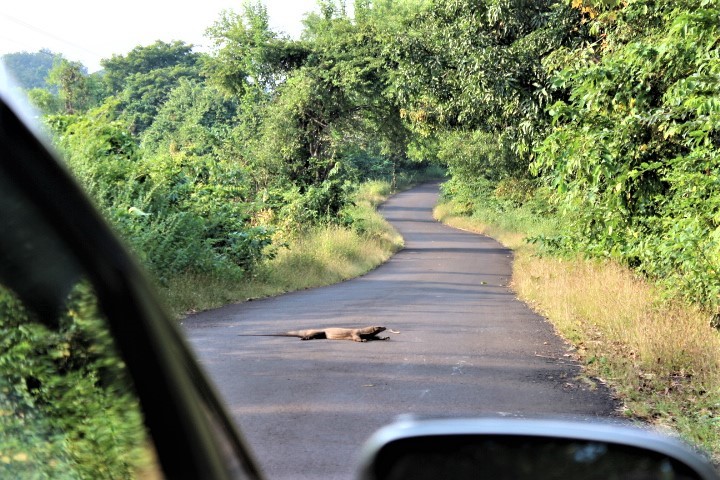 Someone directed us to Mr. Joshi’s residence. Mr. Joshi stayed in a single-storied house, and while he and his wife slept upstairs on the first floor, there was the living room where our driver was given a bed, a guest room where I and my friend would sleep, and the bathroom and family kitchen downstairs. The rates were cheap at twenty-five rupees per person per night, and it looked like a great option for us, especially at that hour. The front room where our driver was to sleep, had large family portraits on the wall, prominently an enlarged photograph of an old lady, probably Mr. Joshi’s mother. This portrait was decorated with many twinkling orange lights draped around it, and connected to the main electricity switch. Hence, it could not be switched off. The old lady twinkled relentlessly, and perhaps we had simply not noticed this earlier in the evening, in the light of the tube lights. But now in the dark, her suffused, never-ending, twinkling glow was unnerving. The Konkan felt rural and dark at nights, where hissing sounds from the ocean sounded loud.
Someone directed us to Mr. Joshi’s residence. Mr. Joshi stayed in a single-storied house, and while he and his wife slept upstairs on the first floor, there was the living room where our driver was given a bed, a guest room where I and my friend would sleep, and the bathroom and family kitchen downstairs. The rates were cheap at twenty-five rupees per person per night, and it looked like a great option for us, especially at that hour. The front room where our driver was to sleep, had large family portraits on the wall, prominently an enlarged photograph of an old lady, probably Mr. Joshi’s mother. This portrait was decorated with many twinkling orange lights draped around it, and connected to the main electricity switch. Hence, it could not be switched off. The old lady twinkled relentlessly, and perhaps we had simply not noticed this earlier in the evening, in the light of the tube lights. But now in the dark, her suffused, never-ending, twinkling glow was unnerving. The Konkan felt rural and dark at nights, where hissing sounds from the ocean sounded loud.
But it was not just the unnerving twinkling lights. Old-lady Joshi’s photo that had probably been touched-up by the photographer who had enlarged it, now took on an otherworldly appearance in the suffused night-time glow. The painted parts of the photo gleamed independently of the photo, with especially her eyeballs gleaming golden in the flickering lights. Our driver, who had earlier boasted of being unafraid, now knocked on our door tentatively, about ten minutes after we had switched off our light. He said, her eyes were not just gleaming and looking at him as he lay on the floor, but her picture was also whispering in the dark. This was too much. We were exhausted. And he was exhausted too, driving all through the day. We suggested it was the sound of the sea.
And then the rats came. Half an hour after we had turned off the lights, we began hearing light thuds. My friend screamed as a rat landed on her face. It scampered across my face in another second and I screamed. We switched on the lights, to see the place alive with rats. They were all over the place, walking along the curtain rods, and shinnying up the edge of the cupboard in the room. There were about seven of them on the bed, on top of the nearby washbasin, and teaming around the corridor outside the door. In another minute, our driver yelled from the front room. As we rushed out, he said there were at least twenty large rats in the room, walking about on the furniture, and along the photo frames on the walls. They disappeared nearly instantly moreover, after we switched on the tube lights. And even as we searched, we could not see where they went. But the scampering feet, the thuds of heavy jumping bodies, and small squeaks started almost immediately as we turned off the lights. It was like a magic trick, as if they had emerged from nowhere and then, disappeared into thin air. The downstairs windows were barred and closed; where did they come from? We looked everywhere, and the three of us trooped into the kitchen. As we switched on the kitchen lights, about fifteen large rats scampered across the dishes, and utensils, and disappeared into the corners. When we looked in those corners, there was no trace of them and nowhere that they could go.
It was late at night, and we felt helpless. Waking up the Joshis, who had padlocked themselves behind a grill at the base of the staircase leading upstairs, seemed out of question. We turned on the lights, trying to sleep sitting-up. Then we decided to sit together in the front room with our driver, who had also switched on the tube-lights in the front room. We all tried to sleep in the front room in a sitting position, and after dozing for an hour, decided to turn off the lights as an experiment—perhaps the rats had fallen asleep!
And it was then, that we heard the whispering. It was not the sea. It was definitely a low whispering from the wall where the photograph hung. As we looked askance at it, we suddenly realized that it was more than just the old lady’s eye-balls that gleamed. Why had we never noticed that the old lady smiled in the photo? The teeth visible between the smiling lips were also gleaming golden in the photographer’s paint. She was laughing because we were beleaguered by rats?! Our driver pointed at the photo, letting out a yelp of laughter laced with alarm. Did we see, he asked? The smile wasn’t there before, was it? No, it wasn’t. Not that we had noticed it. Who notices whether an old woman in an over-enlarged photo in a strange house grins! But now, it was impossible to avoid—the photo’s matt finish, with the eyeballs and teeth glinting golden, added to by the whispering. It was as if Joshi upstairs was whispering into a secret auditory conduit that opened-up in the wall downstairs behind the photo. It was just too much. We raced out of the house, and clambered into the car, and sat there dozing all night. At least we were safe.
Mr. Joshi looked surprised to see us emerging from the car at dawn, all crumpled and exhausted. We were in a black mood, and confronted him about the odd fifty rats that infested his ground floor. We demanded our seventy-five rupees back. At this, he denied ever having any rats in the house, and refused to return our money. We were livid. Of course, he could hardly help it if a rat or two came in. But the number of them inside was overwhelming, and they disappeared into thin air. On top of not warning us about it, he was erasing our travails. And he blamed us in return, saying he had helped out! We were hungry, sleep-deprived, angry, and exhausted, and shouting so loudly that a small crowd gathered. We threatened Joshi that we would go to the police, and also complain about his mother who smiled and whispered from the photograph—this parting shot from our driver. This was the last straw, and Joshi slammed the door in our faces.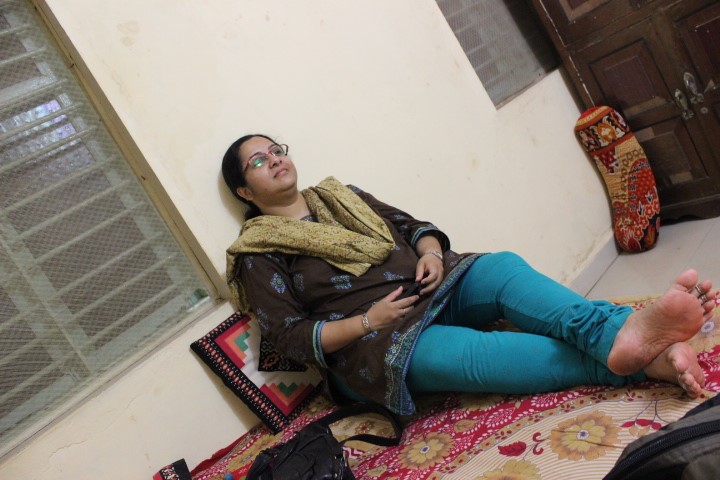
A kindly neighbour who had been interestedly watching, invited us to his house. Why did you go there, he asked? Well, someone told us that this Joshi lets out rooms for guests, I retorted. The neighbour tsk-tsk-ed sympathetically, shaking his head. Yes, it was true he mused: How could we have known Joshi’s ground floor was haunted!? So many people had seen the old woman at night, through the front-room windows that opened on to the garden and street. She was always sitting in the front room, clearly visible in the twinkling lights around her own portrait. She was a good soul, though she had been dead many years. She just sat there every night, guarding the house from intruders. But then, why did Joshi give us poor outsiders those downstairs rooms to sleep in? To deliberately accost us with his family ghosts? I was again nearly shouting. She was definitely whispering, the driver confirmed. I am sure she sent the rats, I proceeded in rage. Where did those dirty beasts come from?
The neighbour tsk-tsk-ed again. Yes, there are many ghosts in Dabhol he said—ghosts almost in every house, building, temple, and mosque. Dabhol was a forgotten city that now lived only through its ghosts. About the rats he continued: It was unlikely that the old woman had sent the rats. It was impossible to avoid rats in Dabhol, he sighed. It was a forgotten port from the ancient past that was once extremely vibrant. A hundred ships full of men from different countries along with their cargo docked every day in Dabhol before the British ever set foot in India. Money flowed like water! But with these shiploads full of men, came their rats. It was as impossible to separate rats from a port, as it was to separate crows from a cremation ground. Just as crows carried away the souls of the dead to the after-world, the rats here carried with them the memory of Dabhol’s ancient, and glorious past. This was Dabhol after all! Did we think we could understand its history without experiencing it first? The rats of Dabhol were part of Dabhol’s history after!
*









Add comment